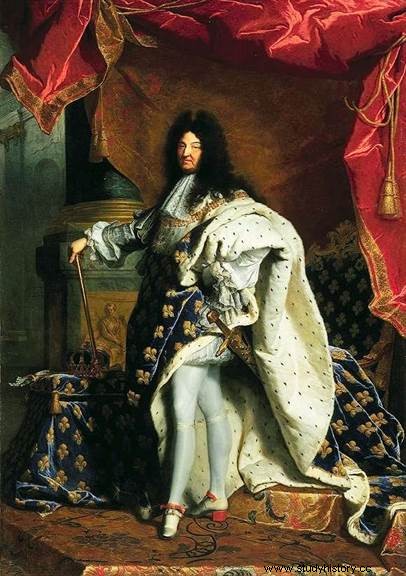 Painted by Rigaud, the full-length portrait of Louis XIV , then 63 years old, is probably one of the most famous of the Sun King. On this portrait nearly three meters high and two meters wide which is one of the most reproduced in history books, Hyacinthe Rigaud (1659 – 1743) wanted to highlight the power and role of Louis XIV, the Sun King, unlike other portrait painters of his time who wanted to express the character of the character painted.
Painted by Rigaud, the full-length portrait of Louis XIV , then 63 years old, is probably one of the most famous of the Sun King. On this portrait nearly three meters high and two meters wide which is one of the most reproduced in history books, Hyacinthe Rigaud (1659 – 1743) wanted to highlight the power and role of Louis XIV, the Sun King, unlike other portrait painters of his time who wanted to express the character of the character painted.
Rigaud, portrait painter at the court of the Sun King
Born in Perpignan, Hyacinthe Rigaud studied at the Royal Academy of Painting and Sculpture and devoted himself to portraits in 1681. He specialized in faces, giving them a perfect resemblance. Appreciated by the Grands of the Court, he painted the Sun King in armor for the first time in 1695 and when he became an Academician, in 1701 he produced this full-length portrait of the king in coronation costume, a portrait that will remain his most famous composition. .
 The King in a solemn bearing, installed in the center, on a platform to make him even taller, not seated on his throne because he wants to be a modern king, occupying almost the entire surface of the painting, first catches the eye of the spectator. All the light is on him and we notice - despite the king's sixty-three years - his elegant and slender leg slightly forward, ready to start a dance step. It is only afterwards that we observe the details.
The King in a solemn bearing, installed in the center, on a platform to make him even taller, not seated on his throne because he wants to be a modern king, occupying almost the entire surface of the painting, first catches the eye of the spectator. All the light is on him and we notice - despite the king's sixty-three years - his elegant and slender leg slightly forward, ready to start a dance step. It is only afterwards that we observe the details.
Everything is symbolic in this portrait:to the right of the king, the marble column symbolizes power and solidity. Themis, Greek goddess of justice, at the bottom of the column, holds scales and a sword:the king must be an arbiter. In the background, the throne symbol of power is surrounded by a purple curtain the color of majesty and placed under a canopy, this canopy forming a sort of frame.
The elements of the coronation also have their symbol:the sword of Charlemagne "the Joyous" marks the protection of the faithful (military power), the golden scepter whose possessor is designated by God to guide his subjects, the crown signifying that the people must be faithful to the king, the hand of justice of Charles V explains the judicial power of the king, the fleur-de-lis whose three petals represent the Father, the Son and the Holy Spirit, the golden necklace and the cross of the Holy Spirit symbols of a wise and thoughtful policy, finally the mantle of the coronation once placed on the shoulders of the king makes Man become a separate Being.
The portrait of Louis XIV will not go to Spain
Originally, this painting commissioned by the king who is sensitive to painting and a great lover of art, was to be offered to his grandson, the new king of Spain Philip V. It was so successful that Louis XIV kept it and only sent him a copy.
This original portrait was exhibited in the Salle du Trône and the Mercure Galant (society newspaper) wrote in 1702 “The Portrait of the King was exhibited in the Grand Apartment at Versailles. It is on foot with the Habit Royal. This book is by Mr Rigaud. Never was a portrait better painted or more resembling. The whole Court saw him, and Everyone admired him. A Work must be very beautiful and very perfect to attract general applause in a place where good taste reigns, and where one is not prodigal of praise”. Reproductions are thus offered in the embassies, but this work remains in the royal collections until 1793 when it enters the Louvre...
With this portrait and this way of painting, we gently enter the "sensual" of the 18th century using the play of light and the beauty of colors.
Louis XIV , by Rigaud. Louvre Museum.
Hyacinthe Rigaud:1659-1743, the man and his art, by Ariane James-Sarazin. Editions Faton, 2016.
